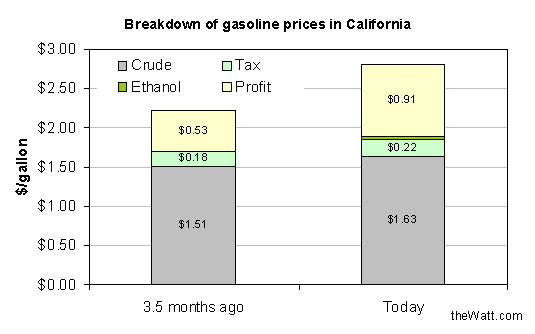And the profits and Tax money are booming from it!
 While California is heralded as a world leader in addressing climate change, An analysis by O'Hare and Alexander Farrell, U.C. Berkeley professor of energy and resources, showed that on account of land-use changes stimulated by greater use of ethanol in motor fuel, "the carbon intensity of California's gasoline" already has risen between 3 percent and 33 percent.
While California is heralded as a world leader in addressing climate change, An analysis by O'Hare and Alexander Farrell, U.C. Berkeley professor of energy and resources, showed that on account of land-use changes stimulated by greater use of ethanol in motor fuel, "the carbon intensity of California's gasoline" already has risen between 3 percent and 33 percent.
 While California is heralded as a world leader in addressing climate change, An analysis by O'Hare and Alexander Farrell, U.C. Berkeley professor of energy and resources, showed that on account of land-use changes stimulated by greater use of ethanol in motor fuel, "the carbon intensity of California's gasoline" already has risen between 3 percent and 33 percent.
While California is heralded as a world leader in addressing climate change, An analysis by O'Hare and Alexander Farrell, U.C. Berkeley professor of energy and resources, showed that on account of land-use changes stimulated by greater use of ethanol in motor fuel, "the carbon intensity of California's gasoline" already has risen between 3 percent and 33 percent. Ethanol can be expected to add more global warming gases in the years ahead as the percentage of ethanol in gasoline climbs, according to scientists.
The analysis comes after California lifted the cap on the ethanol content of gasoline from 6 percent to 10 percent last year in preparation for a low carbon fuel standard. The strategy is aimed at cutting the carbon intensity of motor fuel by 10 percent by 2020.
"All the numbers we've seen so far go the wrong way," said Michael O'Hare, U.C. Berkeley professor of public policy. "It looks like these numbers are pretty big."
"There are things that happen that you can't see," he said.
In a January 12 memorandum to the Air Board outlining their findings, O'Hare and Farrell wrote that shifting one acre of farmland from food production to growing corn for ethanol ripples throughout world agricultural markets. It can result in forest being cut down half way around the world for planting replacement corn for food. Then the forest no longer removes carbon from the atmosphere, but instead decays and releases carbon to the air.
"The analysis suggests that indirect greenhouse gas emissions are larger than direct [ones] due to the large amounts of carbon stored in ecosystems of all sorts," according to the analysis.
The miscalculation in part stems from the so-called GREET model, which the state relied on to make judgments about the life cycle carbon emissions attributable to various fuels, the analysis notes. That model does not account for indirect land-use changes when crops are turned into fuel. As a result, for instance, it underestimates the amount of carbon emissions caused when ethanol is made out of corn grown on conservation reserve program lands--usually fragile areas prone to soil erosion--by 155 times.